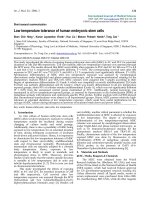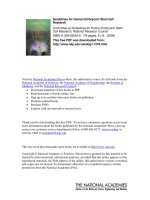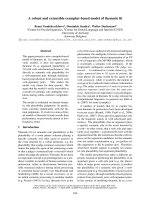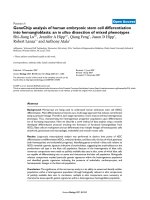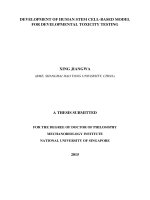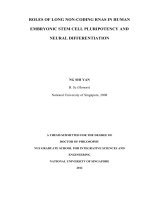A human embryonic stem cell based model of trophoblast formation
Bạn đang xem bản rút gọn của tài liệu. Xem và tải ngay bản đầy đủ của tài liệu tại đây (3.07 MB, 205 trang )
A Human Embryonic Stem Cell–based
Model of Trophoblast Formation
LUO WENLONG
National University of Singapore
2008
A Human Embryonic Stem Cell–based
Model of Trophoblast Formation
LUO WENLONG
(BSc., China)
A THESIS SUBMITTED FOR THE DEGREE OF
DOCTOR OF PHILOSOPHY
DEPARTMENT OF BIOLOGICAL SCIENCES
NATIONAL UNIVERSITY OF SINGAPORE
2008
i
ACKNOWLEDGMENTS
I would like to thank my supervisor Dr. Paul Robson for his guidance and help. Paul
is a responsible supervisor, training me to develop my scientific critical thinking
ability; he also sets an excellent example of a passionate scientist with integrity,
sincerity, understanding and compassion, greatly influencing my personal
philosophy.
I would like to thank colleagues who were involved in this project and helped me to
accomplish it. From our lab, Jameelah Sheik Mohamed and Sun Lili for the human
embryonic stem cell (hESC) culture work and Woon Chow Thai for the microarray
experiments and RNA quality control. From Dr. Neil Clarke’s lab at GIS, Mikael
Huss and Yeo Zhen Xuan have been involved in the microarray data analysis. This
project could only have been successfully accomplished with intimate cooperation
between the above team members. In addition, I would like to thank other members
of our lab - Dr. David Rodda, Dr. Chu Lee Thean, Dr. Wang Chao Yang, Lim Leng
Hiong, Guo Guoji and Teo Tang Yi Roy for their suggestions and encouragement. I
would like to thank Li Pin and Soh Boon Seng from Dr. Lim Bing’s lab, both of
whom kindly shared their cell culture experience with me. I also would like to thank
Andrew Hutchins and Mathia Lee Yu Chun for helping to proof read my thesis and
to provide many constructive comments.
Last but not least, I would like to thank my mother for her love and support in all my
ii
life. Especially during my Ph.D study period, during which she has had to bear with
my extended absence far away over the South China Sea and its accompanying
loneliness, waiting for my Ph.D accomplishment. She must be more proud of this
thesis than I am.
iii
TABLE OF CONTENTS
ACKNOWLEDGMENTS i
TABLE OF CONTENTS iii
SUMMARY ix
LIST OF FIGURES x
LIST OF ABBREVIATIONS xii
LIST OF PUBLICATIONS xix
CHAPTER I. INTRODUCTION 1
1.1 Introductory statement 2
1.2 The early embryo and placenta development 3
1.2.1 Human preimplantation development: from zygote to
implanting blastocyst 3
1.2.2 Early trophoblast morphology and function 6
1.2.3 Key factors modulating early trophoblast development 8
1.2.3.1 Hormone related genes 8
1.2.3.2 Growth factors 11
1.2.3.3 Transcription Factors 13
1.2.3.4 Immune related factors in placenta 18
1. 2.3.4.1 Immunosuppression in placenta 18
1. 2.3.4.2 Non-immune function of immune cells 20
1.2.3.5 Other placenta related factors 21
iv
1.2.4 Clinical relevance of placenta development 22
1.3 Embryonic stem cells 23
1.3.1 Mouse embryonic stem cells 23
1.3.1.1 Derivation of mESC 23
1.3.1.2 Culture condition of mESC 24
1.3.1.3 Core signaling pathway of mESC 24
1.3.1.3.1 LIF/STAT3 24
1.3.1.3.2 Transcription factors 25
1.3.1.4 Mouse trophoblast Stem cells 27
1.3.2 Human embryonic stem cell (hESC) 27
1.3.2.1 hESC derivation 27
1.3.2.2 hESC culture condition 30
1.3.2.3 Core signaling pathways of hESC 32
1.3.2.4 hESC-derived trophoblast cells 33
1.4 FGF and TGF-β Signaling pathway 35
1.4.1 Fibroblast growth factor (FGF) signaling 35
1.4.1.1 Signaling cascade 36
1.4.1.2 FGF receptor isoforms 39
1.4.1.3 FGF signaling involved in mouse early
embryo development 39
1.4.1.4 FGF signaling involved in hESC 42
1.4.1.5 Down-stream pathway of FGF signaling in hESCs 44
v
1.4.2 TGF-β Superfamily of signaling molecules 44
1.4.1.1 BMP signaling 45
1.4.1.1.1 Effectors of BMP signaling 45
1.4.1.1.2 Transcriptional targets of BMP signaling 48
1.4.1.1.3 BMPs in mESC 50
1.4.1.1.4 BMPs in hESC 52
1.5 Specific aims of this study 54
CHAPTER II. MATERIALS AND METHODS 56
2.1 Cell culture 57
2.1.1 Mouse embryonic fibroblasts (MEFs) 57
2.1.1.1 Derivation of MEFs 57
2.1.1.2 Culture of primary MEF 58
2.1.2 Mouse ES cell culture 58
2.1.3 Human ES cell culture 59
2.1.3.1 Culture of hESC on MEF 66
2.1.3.2 Culture of feeder-free hESC 67
2.1.3.3 Cryopreservation of hESC 69
2.1.3.4 Karyotyping 69
2.1.4 Human embryoid body (EB) culture 69
2.2 Bioactive molecule treatments 70
vi
2.3 RNA analysis 70
2.3.1 RNA isolation 70
2.3.2 RNA integrity analysis 71
2.3.3 Reverse transcriptase (RT) 72
2.3.4 Polymerase chain reaction (PCR) 72
2.3.4.1 Conventional PCR 72
2.3.4.2 Taqman real time PCR 73
2.3.5 Microarray analysis 73
2.4 Protein analysis 74
2.4.1 Protein extraction and quantitation 74
2.4.2 Western blot 74
2.4.3 Immunostaining 75
2.4.4 Fluorescence activated cell sorting (FACs) analysis 76
CHAPTER III. RESULTS 78
3.1 Characterization of FGF pathway genes in hESCs 79
3.2 Inhibition of FGF signaling pathway in hESC 83
3.2.1 Morphology of H1 hESC treated with SU5402 83
3.2.2 mRNA expression profiling of H1 hESC treated with SU5402 84
3.2.3 Protein expression of H1 hESC treated with SU5402 89
3.3 BMP4 treatment on H1 90
vii
3.3.1 Morphology of H1 hESC treated with BMP4 90
3.3.2 mRNA expression profiling of H1 hESC treated with BMP4 91
3.3.3 Comparison between hESCs treated with BMP4
versus SU5402 92
3.4 Combined treatment of FGFR inhibitor and BMP4 on hESC 94
3.4.1 Morphology of H1 hESC treated with BS 95
3.4.2 Global gene expression profiling of H1 hESC treated with BS 95
3.4.3 Protein expression of H1 hESC treated with BS 100
3.4.3.1 Immunostaining of H1 hESC treated with BS 100
3.4.3.1.1 Immunostaining of trophoblast related
transcription factors 100
3.4.3.1.2 Immunostaining of
C-Terminal-Phosphorylated-SMAD5 101
3.4.3.2 Western blot of H1 hESC treated with BS 102
3.4.3.3 BS-treated hESC secrete hCG 102
3.4.4 BMP signaling is involved in the differentiation
induced by FGF inhibition 104
3.4.4.1 Morphology 105
3.4.4.2 mRNA expression profiling 105
3.5 Short time treatment of BMP4, SU5402 and BMP4+SU5402
on H1 hESC 108
3.5.1 Early Response Genes 109
3.5.2 Response of BMP direct target genes in SU5402 treatment 113
3.5.3 SU5402 Does Stabilize SMAD5 115
3.5.4 BMP4-independent role of FGF 117
viii
3.5.5 BS effect is not specific to the H1 hESC line 120
3.6 Cell fate commitment time point of H1 hESC treated with BS 124
3.7 Inhibition of FGF signaling in mESC 129
3.7.1 Combination effect of LIF pathway activation and FGF
receptor inhibition on mESCs 129
3.7.1.1 Morphology of treated mESC 129
3.7.1.2 mRNA expression profiling of treated mESC 131
3.7.1.3 Protein expression of treated mESC detected
by Western Blot 132
CHAPTER IV. DISCUSSION 134
4.1 How does this model compare with others? 135
4.2 Mechanism of trophoblast induction by BMP4 and SU5402 136
4.3 Regulatory Networks in Human Placental Development 139
4.4 Totipotency of Human ES Cells? 144
CHAPTER V. CONCLUSIONS AND FUTURE STUDY 147
5.1 Conclusion 148
5.2 Future work 149
REFERENCES 150
ix
SUMMARY
I have established an efficient model of directing human embryonic stem cells
(hESCs) to differentiate into the trophoblast lineage, the embryo’s cellular
contribution to the placenta. This rapid and uniform differentiation process is
induced by the combined treatment of a specific fibroblast growth factor receptor
(FGFR) inhibitor and bone morphogenetic protein 4 (BMP4). Utilizing this model, I
was able to probe the molecular mechanism driving hESCs towards the trophoblast
lineage. This method provides a model to investigate the earliest stages of human
development, an area still largely unexplored due to obvious ethical issues related to
working with human embryos. In addition, the model, with its robust and uniform
differentiation from the hESC, is unique in its utility to understand the molecular
mechanisms involved in the loss of totipotency. This thesis will present studies of
the onset of trophoblast differentiation, the stepwise molecular changes that occur
during this differentiation process. This thesis will then present the commitment time
point determination at which point the differentiated cells can no longer revert back
to the hESC phenotype. Finally this thesis will discuss the specific roles of fibroblast
growth factor (FGF) signaling and BMP signaling during trophectoderm
differentiation.
x
LIST OF FIGURES
Table 1.1 Comparison between mouse and human ESC modified
from literatures 29
Figure 1.1 Intracellular signaling pathways activated through FGFRs 38
Figure 2.1 The Culture and karyotyping of pluripotent hESC 62
Figure 2.2 Immunostaining of pluripotency markers of hESC 63
Figure 2.3 Embryoid bodies derived from hESC 64
Figure 2.4 mRNA expression profiling of human EBs 65
Figure 2.5 The hESC culture 68
Figure 3.1 Characterization of FGF Pathway Genes in hESCs 82
Figure 3.2 The cell morphology of H1 hESC treated with FGFR
inhibitor SU5402 84
Figure 3.3 The 43 placental-enriched genes from the top 100 up-regulated
genes of H1 hESC treated with SU5402 for 7 days 88
Figure 3.4 The immunostaining of pluripotency marker POU5F1
in H1 hESC 89
Figure 3.5 H1 hESC treated with BMP4 93
Figure 3.6 The cell morphology of H1 hESC treated with
BMP4+SU5402 (BS) 95
Figure 3.7 Selected genes from global gene expression profiling
of hESC treated with BMP4, SU5402 and BMP4+SU5402 99
Figure 3.8 Protein detection of BS treated H1 hESC 103
Figure 3.9 Immunostaining for activated SMAD5 in hESC treated
with S, BMP4and BS for short times 104
Figure 3.10 Cell images of H1 hESC treated with BMP4 (B),
BMP4+SU5402 (BS), NOGGIN (N), NOGGIN+SU5402 (NS),
SU5402 (S), and untreated (control) 105
Figure 3.11 Simultaneous inhibition of BMP and FGF signaling in H1 hESC 107
xi
Figure 3.12 Top 20 early expression changes 111
Figure 3.13 Global early expression change comparisons 113
Figure 3.14 Response of BMP4 Target Genes in Single SU5402 Treatment 115
Figure 3.15 Enhanced expression of BMP4 target genes by SU5402 117
Figure 3.16 Genes significantly down-regulated specifically
in BMP4+SU5402 treatment but not in BMP4 only treatment 119
Figure 3.17 Cell morphologies of H1 and HES2 hESC treated
with BS for 2 days 122
Figure 3.18 BS treatments on both H1 and HES2 hESC 123
Figure 3.19 Cell fate commitment time point of H1 hESC
treated with BMP4+SU5402 128
Figure 3.20 The morphology of feeder-free mESC treated with
the combinations of LIF and SU5402 130
Figure 3.21 The mRNA expression profiling of SU5402 treated mESC 131
Figure 3.22 The pluripotency protein NANOG and POU5F1 expression
detected by western blot 133
Figure 4.1 Regulatory network responding to BS treatment in hESC 141
Figure 4.2 Signaling cascades responding to BS treatment in hESC 142
xii
LIST OF ABBREVIATIONS
A Adenine
ACTB beta actin
APC antigen-presenting cell
ART assisted reproductive technologies
bHLH basic helix-loop-helix
BIO 6-bromoindirubin-3-oxime
BMP bone morphogenetic protein
BRE BMP-responsive element
BS BMP4+SU5402
BSA bovine serum albumin
CDM chemically defined media
cDNA complementary DNA
CDX2 caudal-related homeobox gene 2
CGA α subunit of hCG
CGB β subunit of hCG
ChIP chromatin immunoprecipitation
CM conditioned media
Co-SMAD co-mediator SMAD
CSH human chorionic somatomammotropin
CTB cytotrophoblast
xiii
C-terminal carboxy-terminal
CTL cytotoxic T lymphocyte
DAPI 4', 6-diamidino-2-phenylindole
DC dendritic cell
DLX distal-less homeobox
DMEM Dulbecco’s modified Eagle’s medium
DMSO dimethylsulfoxide
DNA deoxyribonucleic acid
dNTPs deoxynucleotide triphosphates
DPBS Dulbecco’s Phosphate buffer saline
dpc days post coitus
EBs embryoid bodies
ECL enhanced chemiluminescence
ECTB endovascular cytotrophoblast
EDTA ethylenediaminotetraacetic acid
EGF epidermal growth factor
EOMES eomesodermin
EPI epiblast
EpiSC epiblast stem cell
ESC embryonic stem cell
EST expressed sequence taq
EtBR ethidium bromide
xiv
ETV4 Ets variant gene 4
FACS fluorescence assisted cell sorting
FBS fetal bovine serum
FGF fibroblast growth factor
FGFR FGF receptor
FN fibronectin
G guanine
g Gram
GATA GATA binding protein
GCM1 glial cells missing 1
GDF growth and differentiation factor
GH growth hormone
GLUT glucose transporter
GPI-AP glycosyl-phosphatidyl-inositol-anchored protein
GREM1 gremlin 1
GSK3 glycogen synthase kinase 3
HAND1 heart and neural crest derivatives expressed 1
hCG human chorionic gonadotropin
HCl hydrochloric acid
HIF hypoxia inducible factor
HLA histocompatibility leukocyte antigen
HRP horse radish peroxidase
xv
HSPG heparan sulfate proteoglycan
ICM inner cell mass
ICTB interstitial cytotrophoblast
ID inhibitor of DNA binding
IGF insulin-like growth factor
IGFBP IGF binding protein
I-SMAD inhibitory SMAD
kDa kilo Dalton
KOSR knock out serum replacement
KRT Cytokeratin
LDHA lactate dehydrogenase A
LIF leukemia inhibitory factor
M Molar
MAPK mitogen-activated protein kinase
MEF mouse embryonic fibroblasts
MHC major histocompatibility complex
MIS muellerian inhibiting substance
ml milli-litre
mM milli-molar
MPSS massive parallel signature sequencing
mRNA messenger RNA
MSX msh homeobox
xvi
N NOGGIN
NaCl sodium chloride
NEAA non-essential amino acids
ng nanogram
nm nanometre
NS NOGGIN+SU5402
P passage
PAGE polyacrylamide gel electrophoresis
PBST PBS+0.1% Tween 20
PCR polymerase chain reaction
PDH pyruvate dehydrogenase
PDK pyruvate dehydrogenase kinase
PE primitive endoderm
PGF placenta growth factor
PHD prolyl hydroxylase
PI3K phosphoinositol-3 kinase
PIG-A phosphatidyl-inositol-glycan class A
PL placental lactogen
PPARG peroxisome proliferator-activated receptor-gamma
PrE parietal endoderm
PTP protein tyrosine phosphatase
RLN1 Relaxin
xvii
RNA ribomucleic acid
rpm revolution per minute
R-SMAD receptor-regulated SMAD
RT reverse transcription
S SU5402
SBE SMAD binding element
SDS sodium dedocyl sulphate
siRNA small interfering RNA
SMURF SMAD ubiquitination regulatory factor
SOS son of sevenless
SOX sex determining region Y-box
STAT3 signal transducers and activators of transcription 3
T thymindine
TBS-T Tris-buffered saline-Tween 20
TE trophectoderm
TEAD TEA domain family member
TFAP2 Transcription factor AP-2
TGF transforming growth factor
Tris trishydroxyaminomethane
TS trophoblast stem cell
V Volt
VEGF vascular endothelial growth factor
xviii
VHL Von Hippel-Lindau
w/v weight by volume
µg microgram
µl microlitre
µM micromolar
xix
LIST OF PUBLICATIONS
1. A Human ES Cell Model to Investigate the Molecular Control of
Placental Development. (poster presented at International Society for Stem
Cell Research (ISSCR) Conference 2007, Cairns Australia)
2. A Human Embryonic Stem Cell–based Model of Trophoblast Formation.
(manuscript in preparation, 2009)
3. Inhibition of methylation releases the developmental plasticity of mouse
embryonic stem cells. Andrew Paul Hutchins
1
, Woon Chow Thai
1
, Tan Siok
Lay
1
, Luo Wen Long
1, 2
, Paul Robson
1, 2, *
(manuscript in preparation, 2009)
4. Integrative epigenome analysis identifies the differentiation regulator
HAND1 as a putative tumor suppressor silenced in colorectal cancer.
Jing Tan
1*
, Xiaojing Yang
1*
, Xia Jiang
1
, Jianbiao Zhou
2
, Zhimei Li
1
, Puay
Leng Lee
1
, Meiyee Aau
1
, Wenlong Luo
3,6
, Shaw Cheng Liu
2
, Jianhe Wang
4
,
Shing Chuan Hooi
2
, Chien-Shing Chen
2
, Baojie Li
4
, Chia Lin Wei
5
, Edison T.
Liu
1
, Paul Robson
3,6
, Yijun Ruan
5
, Qiang Yu
1,7
. (under review)
1
CHAPTER ONE
INTRODUCTION
2
1.1 Introductory statement
Embryonic stem cells (ESCs) are derived from the inner cell mass (ICM) of the
preimplantation embryo. ESCs are pluripotent stem cells as, under well established
culture conditions, they have the ability to both remain undifferentiated by way of
self-renewing cell division while still maintaining the ability to differentiate to
almost all types of tissue. This ability to differentiate into all cell types is what drives
the extensive clinical interest in human ESCs as there is great potential for use in
medical applications such as cell-based therapies. For the medical use of ESCs, it is
essential to understand the mechanisms involved in maintaining ESCs in their
pluripotent, self-renewing state, and the mechanisms involved in their differentiation
towards certain cell lineages. My thesis is focused on describing the earliest events
of differentiation along the trophoblast lineage and blocking essential signals
required for the maintenance of the undifferentiated hESC. As such, this introduction
provides background on the culture conditions and the underlying molecular
mechanism controlling the undifferentiated hESCs. I also include a review of the
underlying molecular mechanism controlling the undifferentiated mouse ES cells to
highlight the similarities and differences of ES cells between human and mouse. I
will review the FGF and BMP signaling pathways as these are the two signaling
pathways for manipulation in my study,. Also included are reviews on early events
in human development, placentation, and the trophoblast lineage.
3
1.2 The early embryo and placenta development
Unlike a number of other mammalian species that are more amenable to
experimentation, there is very little molecular data available on early human
development. There is extensive knowledge of human preimplantation embryo
morphology as morphological criteria are used clinically to choose embryos for
transfer in assisted reproductive technologies (Urman et al., 2007). Any human
cell-based model that is relevant to these developmental stages would have a great
impact on the field of assisted reproductive biology allowing experimentation that
does not depend on a limited supply of human embryos excess to reproductive
technologies. The current understanding of human blastocyst biology and
implantation is described below.
1.2.1 Human preimplantation development: from zygote to implanting
blastocyst
Preimplantation development refers to the period of development from the point at
which the egg is fertilized by the sperm up until the time when the embryo implants
into the uterine wall of the mother. By definition this developmental program is
restricted to the mammals (eutherians and metatherians) as non-mammalian
vertebrates lay eggs after internal fertilization (birds, reptiles, and prototherian
mammals) or begin development by the external fertilization of eggs (amphibians
and fish). Human ovulation occurs in each menstrual cycle, whereby the human
oocyte is delivered from the ovary into the fallopian tube. Within 48 hours of
4
ovulation, the human oocyte must be fertilized by the sperm in the fallopian tube
whereupon it will begin to develop into a full organism. The newly fertilized zygote
then passes through the fallopian tube towards the uterus. The developmental
progression from the 1-celled zygote to the morula, when the embryo is a compacted
ball of cells without a fluid-filled cavity, occurs in the fallopian tube. Two to three
days after fertilization, the morula reaches the uterine cavity and subsequently
develops into a blastocyst.
The blastocyst is defined by its fluid-filled cavity, the blastocoel. The single outer
layer of cells in the blastocyst, and the one responsible for cavity formation, is
termed the trophectoderm (TE). The TE is the first epithelium that forms in
mammalian development. The TE will subsequently give rise to all extraembryonic
ectoderm/trophoblast cell types that contribute to the placenta. Although yet to be
characterized in molecular detail in human, extrapolating from the mouse we know,
the ICM within the blastocyst consists of two cell types: the epiblast and the
primitive endoderm (PE). The epiblast, after implantation, will give rise to the three
germ layers (definitive ectoderm, mesoderm, and endoderm) and to the germ cells
themselves and thus to all cells in the whole fetus and to subsequent generations. The
PE gives rise to all extraembryonic endoderm structures such as those found in the
yolk sac. About 3 days after entering the uterus, the blastocyst hatches from the zona
pellucida which is a non-adhesive and protective extracellular layer enclosing the
embryo since fertilization. This hatching occurs much earlier in development than
hatching in birds and other non-mammalian vertebrates and is the beginning of the
